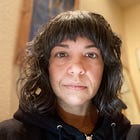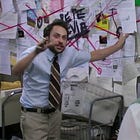The Value of Feedback
On that novel of mine that's majorly on the backburner.
Hi everyone!
So happy to have you here. I hope this post brings you a bit of early morning joy despite the clocks springing forward in the U.S.
Let’s get to it!
On Keeping Going
A quick note about last week’s post — thank you so much to those of you who touched base with me, either through comments or through email. It meant a lot to hear from you. I appreciate that I can share my struggles and know that y’all have my back.
I was particularly intrigued by a comment from my dear friend Blair Glaser that what I’m going through is specifically the trauma response of survivor’s guilt. (Check out her excellent newsletter, the HI Stack, which is all about prioritizing human intelligence instead of AI.)
That makes sense: I often interview people who experienced far more hardship in the wake of Hurricane Helene, and the emotional detachment I’ve had since then may come from a sense that I have no right to feel sad or upset. It’s not my house that’s damaged. It’s not my life turned upside down.
Plus, I have the added guilt of someone whose career has thrived because so many others suffered. I didn’t cause the storm, and I’m not exploiting people. Still, I am asking sources to share their most traumatizing moments for a story that earns me money. Telling these stories is the right thing, and I should get paid for it. But it’s one thing to know that objectively and another to feel it.
In some good news: I won a free Trauma Recovery — Level 1 course from Emma Churchman, who wrote the wonderful book The Deep End of Hope in the Wake of Hurricane Helene: 40 Days and Nights of Survival and Transformation. (I wrote about it for the newsletter in the wake of attending her book launch.) She served as trauma chaplain for her community and has now created a series of courses to help others work through trauma and help others.
Level 1 is a 15-day course designed to help you recognize your triggers and mitigate them. I’ve only done the first two days, but even winning the free course felt fortuitous.
I’ll keep you posted.
Brief PSA: Get Your Guts Checked
I spent the beginning of the week in a familiar situation: prepping for and then having a colonoscopy.
I was ten when I had my first scope, and I’ve had plenty since. When I was younger, I got them to see how inflamed my colon was from Crohn’s Disease. But since I was 18, I’ve mostly had them to check for colon cancer.
My inflammatory bowel disease raises my risk of colon cancer, but the real issue is that my mother had colon cancer when she was 44. They caught it later than they should have, considering how long she had rectal bleeding that doctors dismissed as hemorrhoids. But the cancer had not spread, so she was cured by having her colon removed.
Colon cancer is the third most-diagnosed cancer in the U.S. and the second deadliest. This last stat is a bummer, because when caught early, it is very, very survivable. (See: my mom.)
Because of my risk factors, I get a colonoscopy every 2-3 years. If your risk is average, however, you only need to start screening at 45 — and you don’t even necessarily have to do a colonoscopy! The American Cancer Society recommends a yearly Cologuard mail-in test and an actual scope every 10 years.
Colonoscopies seem scary, and I won’t lie: the prep is not fun. You drink crappy-tasting shit and then shit your guts out. You can only drink clear liquids (thankfully, Coke counts) and eat Jell-O as long as it’s not red or orange (easy to mistake for blood). The day of the test is pretty mundane, as you’re sedated. Sometimes you can feel bloated afterward, since the scope introduces a bit of air into your gut. Again, not fun.
But you know what’s less fun?
COLON CANCER.
And colon cancer progresses relatively slowly. I’m getting tested every 1-3 years because that is a window that allows my doctors to catch any cancer before it moves beyond Stage 1.
So, get your stool tests. Get that once-a-decade colonoscopy. If you have a first-degree relative (parent, sibling, child) who had colon cancer, you should start screening earlier and more often — talk to your doctor.
Similarly, if a relative had any flat or “adenomatous” polyps in their own scopes, you might need more or earlier screening.
If you want a cheerleader to get you through the scope prep, or to give you the courage to poop in a box and send it in the mail, come talk to me. Fun? No. Life-saving? Literally.
Friendly Feedback
In 2021-22, I was one of 12 people selected to do StoryStudio Chicago’s Novel in a Year course. It was a fantastic experience with a great teacher, Michael Zapata, author of the wonderful novel The Lost Book of Adana Moreau.
But best of all has been the friendships I’ve made. Since then, a handful of us have continued to meet online to share how we’re doing. And this year, we started a workshop.
I went first. I probably shouldn’t have? I initially wanted to get a writing sample in shape for applying to prestigious fellowships and conferences like Sewanee and Bread Loaf. But reporting on the storm has continued to take precedence, and I realized I did not have the bandwidth to do that. In fact, they had to listen to me air out my vicarious trauma/survivor’s guilt/whatever for a good 45 minutes before we got to their excellent feedback on my prologue.
My prologue, called “1346-80: The Choir Screen,” is a short chapter that provides the origin story for 107 statues in Durham Cathedral that go missing in 1539, the year when the main action of my novel takes place. Those statues were created as part of the Neville Screen, a choir screen erected in the cathedral in 1380.
I’ve written about the actual screen that you can still see in Durham Cathedral here:
My NIAY friends helped me articulate a central organizing principle (to borrow a term from my PhD days) guiding “The Choir Screen,” and the novel as a whole: to take seriously the depth of religious belief of the time period and especially the existential terror that the Reformation brought to Catholic England.
In the time period of “The Choir Screen,” the Reformation is unthinkable. But the existential dread of ensuring that your works on Earth guarantee you a trip to Heaven (or at least a shorter time in Purgatory) is very present. The chapter starts with the future knight John Neville on his first battlefield, a mere child. (I cover why this is historically accurate in the post above.) He vows to honor God and St. Cuthbert, the patron saint of Durham Cathedral, in some way for sparing his life and giving the English forces victory over the Scots in what became known as the Battle of Neville’s Cross. Over the ensuing decades, he serves the English crown as a knight, journeying as far as Italy and living most of his life defending the crown’s interest in what’s now the south of France. The Neville Screen is completed and erected in 1380, and Neville dies only five years later, in 1385.
What my NIAY friends recognized was that I was spending a lot of time straying from that central organizing principle of Neville’s religious belief. For instance, I spent a long time describing the quarrying of the limestone from Caen in Normandy, its journey to London, and its carving by master mason Henry Yevele before getting sent up north to Durham. I had thought that showing the time and effort given to making this choir screen was a way of “showing,” not telling, its religious significance. But it proved more of a distraction from that central point: the beauty and expense and intricacy ultimately stemmed from Neville’s desire to glorify God.
That’s not to say that nobles like Neville didn’t want to show off their economic power as well. But we tend to understand that motivation far more than the religious aspect, even though they are inextricable.
So, my next step — when I have time — is to pare away everything in the chapter that veers away from that central principle of Neville’s belief in the power and responsibility of his vow. That feels exciting.
I also got feedback this week on my first two paragraphs from Courtney Maum, the brilliant writer behind the Before and After the Book Deal Substack. I’d actually revised these paragraphs based on previous feedback after taking one of Courtney’s webinars on opening pages.
Here are the paragraphs that Courtney commented on this week:
John Neville made the vow in his ninth year, mouthed it into the kicked-up dirt where his face had landed after his palfrey threw him. Minutes before, he sat tall and proud beside his father, his first plate of armor snug against a leather vest. A pennant bearing the Neville coat of arms flapped in red and white silk above his head. His ancestry made him a captain of men more than twice his height and three times his age. When the moment came, he lifted the lightweight saber he’d named Point and squeaked out the fighting words his father had made him practice the night before: “For King Edward and County Durham, Home of the Prince Bishops!” The roar he got back swelled his pride and his chest.
But then the fighting began, and he learned that the stories shared by his father the night before to sober him up were real. Metal screeched as it bit into metal. Horses screamed — including his own Lionheart when a blade sliced the side of his taut, dappled grey belly. Men yelled even as their heads flew off their bodies, struggling to stay aloft like wounded birds before landing heavy in the grass. He cried out, too, when Lionheart bucked and he bounced out of the stirrups. He landed, hard, face down, in the midst of the melee, the air punched out of him by the ground.
Courtney loved my first paragraph — yay! And she had a great note for the second: a suggestion that the language mimic more how Neville might think as a young boy. So, rather than writing about heads “aloft like wounded birds,” I would use a simile far more likely to come from the head of a young, frightened boy.
It’s a fascinating thought and one to carry throughout the whole chapter. I didn’t fully recognize that I had moved from a more distant narrator in the first paragraph to more of his point-of-view in the second.
It’s late and has been a long day, so I don’t have the energy to try a revision out here, like I did with in the previous post. But all the feedback I’ve received recently is bite-sized and manageable. Revise a paragraph. Reread a chapter and weed out the chaff. Free write on Neville’s faith and how it changes over the years.
Of course, it sounds bite-sized in theory. In practice, it can be a different story.
We’ll see how it goes.
Hurricane Helene: Ways to Support Recovery
Love Asheville From Afar. This one-stop shop features Asheville businesses that desperately need money to survive the slow winter season. From coffee and food to art of all shapes, to simple donations, you can get a range of thoughtful gifts for just about anyone in your life.
Asheville Goods. Another site where you can buy themed boxes featuring a bunch of local shops — or customize your own!
Help Catye Gowan Feed People with Dietary Needs! This chef has been out there on her own since the storm began cooking food designed for people with severe dietary issues like Celiac and dietary preferences like veganism. She’s a force for good, and every dollar helps!
BeLoved Asheville. These folks are the best in the world — the ultimate model of mutual aid and greeting the world with love. Check out what they’ve been doing, and donate, here.
The Deep End of Hope in the Wake of Hurricane Helene: 40 Days and Nights of Survival and Transformation. A Ground Zero view of the storm’s devastation — and a community’s resilience — from a trauma chaplain who lived it.
L.A. Wildfires: Opportunities to Help
World Central Kitchen. They were unbelievable for us here after Helene. I don’t know the grassroots organizations running in LA right now — LA readers, feel free to share so I can include them! — but I can vouch for the amazing-ness of World Central Kitchen. A hot meal means everything in such difficult moments. I’ll add more links as I hear about places doing great work.
Support Karen and Ingin’s Recovery from the Eaton Fire. I was asked to share this GoFundMe for a journalist of color. If you can, check it out and give.
This Week’s Dose of K-Pop: ENHYPEN (엔하이픈), “Sacrifice (Eat Me Up)”
ENHYPEN’s lore is that they are vampires, so the idea of sacrifice in this video has nothing to do with religious sacrifice. But the obsession in the lyrics well fits the depth of the faith that I believe most medieval Europeans had. And, now that I look at the video again, we do have some Christian iconography, from angel wings to Heesung (the one with the silver hair) dressed in somewhat popish garb when not wearing a cardigan. (Tee hee. K-pop is deliciously ridiculous sometimes.)
Love y’all
Sara






Thank you for sharing this during Colorectal Cancer Awareness Month! I just did my Cologuard testing -- super easy! As we say at ACS, the important thing is that you get tested.
Sending you love from LA!
Yes... the prep for colonoscopies are not great, but the process is much better than it used to be a couple of decades ago. My first prep had me in so much pain I was on the bathroom floor sobbing in agony. But now? I may be one in a million (and I have only heard second hand of someone else who feels the same) but I look forward to colonoscopies for this reason: after the scope is completed I feel light as a feather and my bowels (for a few days at least) work well like I imagine they are supposed to and like most people's do. I feel super healthy for a couple of days and that is a great feeling so if you're at all hesitant to get it done, maybe you'll feel the same.